As is typical for the release of a new MTG set, players start playing some sets, and some powerful cards stand out. Sometimes some of the more glass-cannon strategies, like the one featured here, disappear after some time. In other cases, cards like Sheoldred, the Apocalypse establish themselves as new pillars to the metagame that don’t go away but have their impact mitigated as players come up with ways to stop them. As expected, another new menace is starting to terrify best-of-one Arena players while making a splash in other formats. There are a surprising amount of people getting killed in turns three-four by Venerated Rotpriest combos in Standard.
Venerated Rotpriest
i think venerated rotpriest is going to be banned
— mugi! (@scarlet_mugi) February 8, 2023
I hate it.
— Clipcitybish (@lukeeatonsbox) February 7, 2023
playing the new MTG set on arena and venerated rotpriest is exactly as busted as i thought it be
— Stinky Fox ( cookie haver era ) (@foxvomit) February 8, 2023
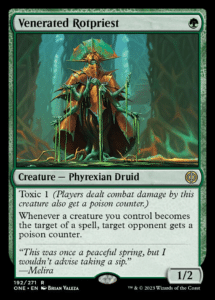
Venerated Rotpriest is a one-mana Toxic creature that combo players immediately started getting excited about. While this 1/2 may look like basic additional cost to remove your creatures with spells at first glance, that’s not how this card is being used. Venerated Rotpriest adds Poison Counters to your opponent regardless of who targets it with spells. This means that if you build a deck based around targeting Rotpriests with various spells, you can amass several Poison counters very quickly. While this has led to turn 3-4 kills in Standard, the card has been causing a bunch of turn-two kills in older formats like Modern. While the card may fit into a Storm shell in that format, we haven’t had a combo deck that kills this quickly in Standard for some time. Let’s look at some of the key cards players are using to pull off turn 3-4 kills with Venerated Rotpriest!
Venerated Rotpriest in Standard
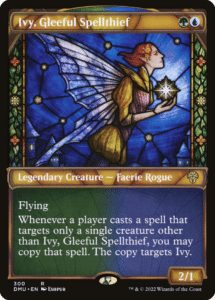
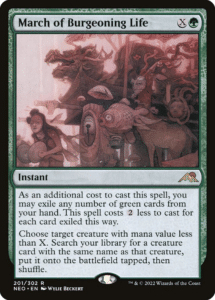
The most common suite of cards being played alongside Venerated Rotpriest are March of Burgeoning Life and Ivy, Gleeful Spellthief. If you have a Rotpriest in play, March of Burgeoning Life can target it for two mana and search for another Venerated Rotpriest in your library, putting it into play. This not only adds a Poison Counter to your opponent since Venerated Rotpriest was targeted by a spell but since there’s two Rotpriests now in play, the amount of Poison counters per targeted spell will double.
Ivy is a potent reminder that Venerated Rotpriest doesn’t have to be targeted by these spells to administer Poison Counters to your opponent. Any of your creatures targeted by a spell will trigger the Rotpriest. Ivy cares about copying spells that target a single creature on the battlefield. While it may not be wise to use this effect on an opponent’s Go for the Throat (but, situationally, it could provide the last Poison Counter trigger you need), these additional targets count as Rotpriest triggers.
Read More: MTG’s Newest Format May Be the Fastest in Recent History!?
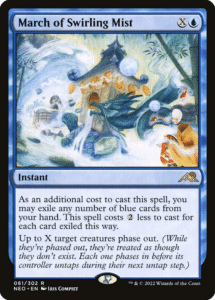
March of Burgeoning Life isn’t the only March spell doing a ton of work in the deck. March of Swirling Mist plays many roles, acting as protection, a combo piece, and a fog effect all in one! Since this can phase out any creature, March of Swirling Mist can target all of your creatures, triggering Rotpriest an alarming number of times. Alongside the March of Swirling Mist are a series of targeting and protection spells that can help your Rotpriest survive your opponent’s removal while simultaneously accelerating your win condition. These cards include options like Shore Up and Slip Out the Back.
These cards open up a variety of frightening kill options. Take the sample combo as an example:
T1 – Play Venerated Rotpriest
T2 Attack, placing a Poison Counter. Use March of Burgeoning Life to find another Rotpriest, putting another Poison Counter on the opponent – or you can play a second one and use a targeting spell.
T3 Attack with both Rotpriests, adding two more Poison Counters. Past this point, you need three targeted creatures to win the game, which can be done with Shore Up, March of Swirling Mist, or any other targeting spell. Notably, this is much easier if you have one of the Marches that can have its costs reduced by exiling cards in your hand.
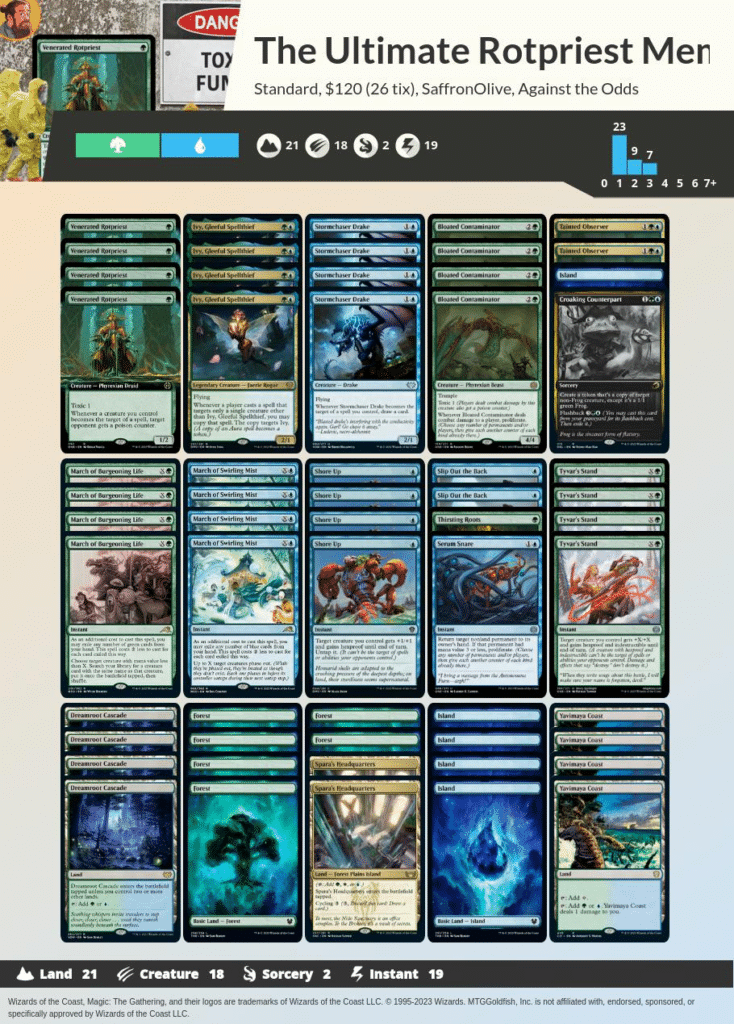
Provided by MTG personality SaffronOlive is a sample decklist for the Standard Venerated Rotpriest combo if you want to try it yourself. That said, there are already endless takes that spin-off of this decklist. This idea originated from a pile of brews from Twitter user @yoman_5, known for brewing a whole bunch of wacky Standard decks before the release of a new set.
Where is this an Issue?
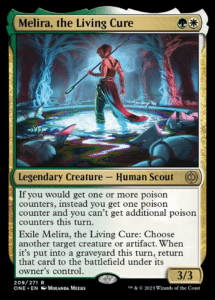
As players adjust to the new aggressive combo strategy, there’s a chance it may disappear rather quickly. While this is attacking the Standard format in a unique way, the deck is also rather fragile and inconsistent, a glass cannon, if you will. If the Venerated Rotpriest player doesn’t find the namesake card to the strategy, the deck doesn’t do anything and dies without putting up much resistance. Targeting the Rotpriest with removal may not feel good since it’s adding Poison Counters to you, but getting off the field as soon as possible helps ensure that your opponent won’t be able to find more with their March of Burgeoning Life. If this truly starts taking over the format, there are removal options that work around Venerated Rotpriest’s abilities, like Brotherhood’s End and Circle of Confinement. If the strategy needs more targeted hate Melira, the Living Cure takes this strategy and puts its speed to a screeching halt.
Players that may continue having problems with Rotpriest combos are those who prefer playing Best of One. This means there will be no opportunity to side into specific answers to the Rotpriest combo like Melira. Sure, you’ll have games where the Rotpriest player does not find the namesake card and dies horribly, but you’ll also have games where you get killed in the first few turns without a chance to react. This presents a potentially unfun play pattern that heralds back to cards like Tibalt’s Trickery and the Book of Exalted Deeds. While all of these were easy to play around in Best of Three scenarios with sideboardable answers, they all need precise answers that typically aren’t included in maindecks. While these examples were banned in the past and may be too extreme, the point is that cards have been banned in Best of One before for creating unenjoyable gameplay patterns. I have no idea if Rotpriest is going to be quite that bad, however.
Read More: Controversial MTG Mulligan Overhaul Could Become Reality

